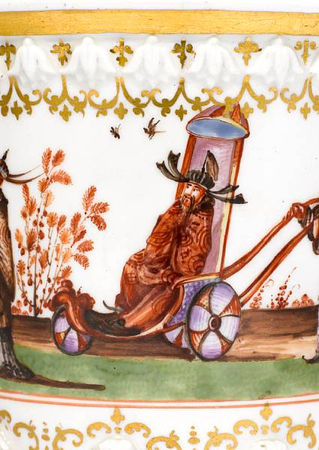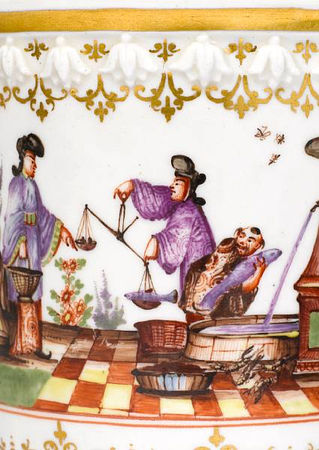A very rare pair of Meissen covered tobacco jars. Circa 1725
A very rare pair of Meissen covered tobacco jars. Circa 1725
Each moulded with a border of bellflowers below the rim and an acanthus-leaf border embellished in gilding above the footrim, superbly painted, possibly by Augustin Dietze, in enamels and Böttger lustre with a continuous chinoiserie scene in the manner of J.G. Höroldt, depicting figures engaged in various amusing pursuits, flanked by trees, flowering plants and rockwork, the moulded borders embellished with gilt scrollwork, the domed covers moulded with acanthus borders edged with gilt and iron-red scrollwork, surmounted by knopped finials above indianische Blumen, the footrims with iron-red borders of concentric semi-circles, 17.1cm high (covers restored, one with restored chip to footrim, some tiny rim chips) (4). Sold for £38,400
Footnote: Sold on behalf of the Collection Fund of the British-American Tobacco Association.
Provenance: Anon. sale, Christie's Geneva, 12 May 1985, lot 187
Notes: According to the weekly reports of the formers and turners in the Meissen factory, the form was made from 1724 (Boltz 2002, p. 75), though it is clearly derived from a similar form in Böttger stoneware with additional female masks to the side, probably designed by the Court silversmith, J.J. Irminger, for which see Boltz 2000, fig. 31.
This particularly elaborate style of chinoiserie decoration has long been associated with the painter Philipp Ernst Schindler, who joined Höroldt's workshop in 1725, based upon the monogram 'PES' in the backrest of a chair in a scene on a circular stand in the Ernst Schneider collection. Diethard Lübke has, however, recently argued (Lübke 2008) that the monogram stands for Princeps Elector Saxoniae or Hereditary Electoral Prince of Saxony, and that the chinoiserie lady seated on the chair is therefore intended to represent Maria Josepha, Augustus the Strong's daughter-in-law and future Electress of Saxony and Queen of Poland. Lübke has identified fifteen characteristics of this painter that can also be found on the present lot - including the use of lustre within the painted scenes, the careful delineation of fabric folds, and the distinctive faces and headdress of the figures - and which can be identified on pieces dating to before Schindler's arrival in 1725. Instead, Lübke proposes one of the most talented and best-paid of Höroldt's artists, Augustin Dietze (1696-1769), as the painter of this distinctive chinoiserie style.
A similar beaker and cover in a private collection is illustrated in Frühes Meissener Porzellan: Kostbarkeiten aus deutschen Privatsammlungen, exhibition catalogue, Hetjens-Museum, Düsseldorf 1997, no. 8. These tobacco jars are published and discussed by Gage 1988, p.104 and 105, where she notes other comparable examples can be found published in Berling 1910, plate 8, and Treasure Houses of Britain: 500 years of Private Patronage and Art Collecting, The National Gallery of Art, Washington 1985-86, two jars from the Trevelyan collection, and in the collection of Dr Erika Pauls-Eisenbeiss, German Porcelain of the 18th Century, Vol I, pp 432f.
Bonhams. Fine European Ceramics, 3 Dec 2008. New Bond Street. Copyright © 2002-2008 Bonhams 1793 Ltd., Images and Text All Rights Reserved. www.bonhams.com

/https%3A%2F%2Fprofilepics.canalblog.com%2Fprofilepics%2F1%2F0%2F100183.jpg)
/https%3A%2F%2Fstorage.canalblog.com%2F03%2F02%2F119589%2F96711876_o.jpg)
/https%3A%2F%2Fstorage.canalblog.com%2F11%2F31%2F119589%2F94773502_o.jpg)
/https%3A%2F%2Fstorage.canalblog.com%2F20%2F83%2F119589%2F94772815_o.jpg)
/https%3A%2F%2Fstorage.canalblog.com%2F26%2F72%2F119589%2F75604929_o.jpg)
/https%3A%2F%2Fstorage.canalblog.com%2F59%2F60%2F119589%2F26458628_o.jpg)











/http%3A%2F%2Fstorage.canalblog.com%2F28%2F56%2F119589%2F129494680_o.jpg)
/http%3A%2F%2Fstorage.canalblog.com%2F04%2F81%2F119589%2F128791640_o.jpg)
/http%3A%2F%2Fstorage.canalblog.com%2F73%2F16%2F119589%2F128381257_o.jpg)
/http%3A%2F%2Fstorage.canalblog.com%2F28%2F03%2F119589%2F126225626_o.jpg)